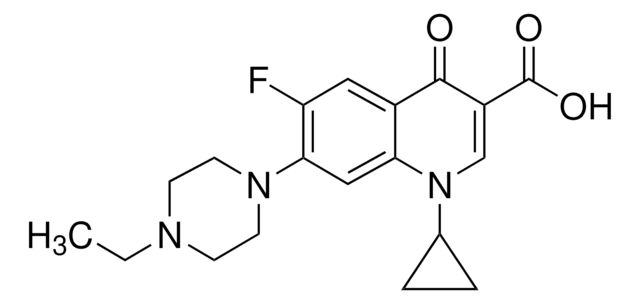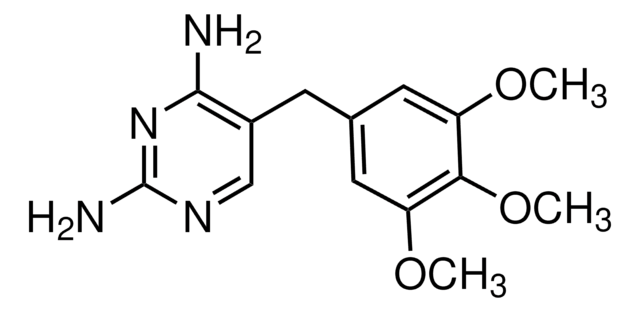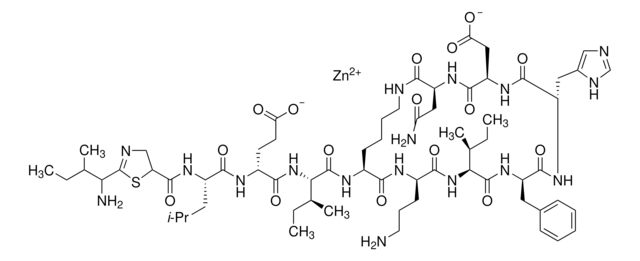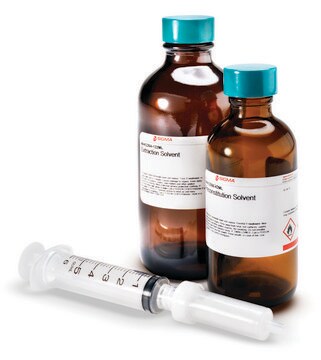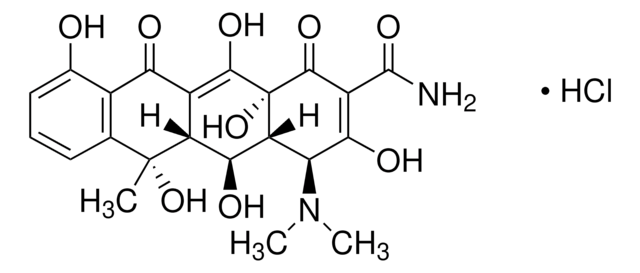Key Documents
17849
Enrofloxacin
≥99.0%
Synonim(y):
Baytril
About This Item
Polecane produkty
Poziom jakości
Próba
≥99.0%
99.0-101.0% (dried substance)
Postać
powder or crystals
spektrum działania antybiotyku
Gram-negative bacteria
Gram-positive bacteria
Tryb działania
DNA synthesis | interferes
enzyme | inhibits
ciąg SMILES
CCN1CCN(CC1)c2cc3N(C=C(C(O)=O)C(=O)c3cc2F)C4CC4
InChI
1S/C19H22FN3O3/c1-2-21-5-7-22(8-6-21)17-10-16-13(9-15(17)20)18(24)14(19(25)26)11-23(16)12-3-4-12/h9-12H,2-8H2,1H3,(H,25,26)
Klucz InChI
SPFYMRJSYKOXGV-UHFFFAOYSA-N
Szukasz podobnych produktów? Odwiedź Przewodnik dotyczący porównywania produktów
Opis ogólny
Zastosowanie
- to investigate the pathological mechanisms resulting from the toxicity of fluoroquinolones in mammalian cells
- to prepare a standard solution with 50% acetonitrile in a study to analyze illegal fish drugs used in aquaculture by employing surface-enhanced Raman spectroscopy (SERS)
- as an analyte in a chemiluminescence reagent system
Hasło ostrzegawcze
Danger
Zwroty wskazujące rodzaj zagrożenia
Zwroty wskazujące środki ostrożności
Klasyfikacja zagrożeń
Acute Tox. 4 Oral - Resp. Sens. 1 - Skin Sens. 1
Kod klasy składowania
11 - Combustible Solids
Klasa zagrożenia wodnego (WGK)
WGK 3
Środki ochrony indywidualnej
Eyeshields, Gloves, type N95 (US)
Wybierz jedną z najnowszych wersji:
Masz już ten produkt?
Dokumenty związane z niedawno zakupionymi produktami zostały zamieszczone w Bibliotece dokumentów.
Klienci oglądali również te produkty
Nasz zespół naukowców ma doświadczenie we wszystkich obszarach badań, w tym w naukach przyrodniczych, materiałoznawstwie, syntezie chemicznej, chromatografii, analityce i wielu innych dziedzinach.
Skontaktuj się z zespołem ds. pomocy technicznej
